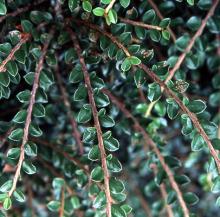Cotoneaster apiculatus 'Tom Thumb'
Common name:
Tom Thumb Cotoneaster
Tom Thumb Cranberry Cotoneaster
Pronunciation:
ko-toe-nee-AS-ter a-pik-U-la-tus
Family:
Rosaceae
Genus:
Synonyms:
‘Little Gem’
C. adpressus ‘Tom Thumb’
C. adpressus ‘Little Gem’
Type:
Broadleaf
Native to (or naturalized in) Oregon:
No
- Deciduous to semi-evergreen shrub, 6-12 inches (15-30 cm) tall, but grows slowly to form a mound 1-2 ft (30-60 cm) tall, branch tips root where they touch the9 ground and it may spread to 3-6 ft (0.9-1.8 m) wide or more. Leaves alternate, simple, orbicular-ovate, about 1.5 cm wide, glossy dark green, turn bright red in fall. Sometimes described as rarely forming flowers or fruits, whereas elsewhere it is described as having tiny pink flowers and red fruit. Possibly more than one form marketed under this name.
- Sun to light shade. Easy to grow, but best in moist, well-drained soil, but frequently recommended for dry climates.
- Hardy to USDA Zone 4 ‘Tom Thumb’ appears to have uncertain origins, and one may find it listed as a selection of Cotoneaster apiculatus, C. adpressus or C. horizontalis.
- apiculatus: after apiculate, ending abruptly in a small, slender point, a reference to the tip of the leaf
- adpressus: leaves appressed against the stem.


